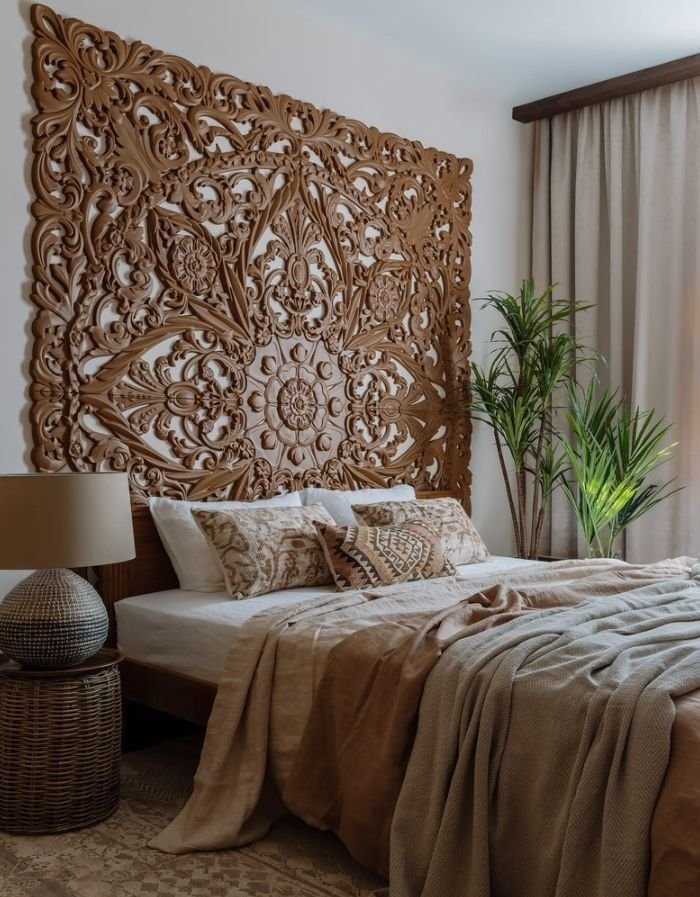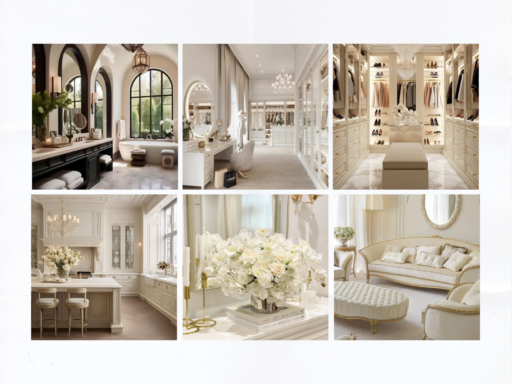Moroccan decor is renowned for its vibrant colors, intricate patterns, and rich textures, bringing a unique cultural essence into your home. Exploring the top Moroccan decor ideas can transform your space into a warm and inviting environment that reflects the beauty of Moroccan artistry.
Incorporating Moroccan elements can seamlessly blend contemporary and traditional styles, creating a stunning aesthetic. Whether you are looking for bold statement pieces or subtle accents, the right decor can elevate your living area and create a sense of harmony and comfort.


1) Moroccan Lanterns
Moroccan lanterns are a striking element in interior design. They bring a unique blend of cultural significance and artistic beauty to your space.
These lanterns are often crafted from metal and glass, featuring intricate designs that cast beautiful shadows. Placing them in various areas of your home can create a warm, inviting atmosphere.
You can use them as centerpieces on tables, hang them from ceilings, or place them on windowsills. They come in various sizes and styles, allowing you to mix and match for a customized look.
For a cohesive aesthetic, consider pairing lanterns with other Moroccan decor elements. The glow of the lanterns complements textiles, ceramics, and woodwork beautifully.
Lighting options vary as well. You can choose between candles for a traditional feel or LED lights for convenience. Moroccan lanterns are not just decoration; they are a statement of style.


Handmade Berber Rugs
Handmade Berber rugs are a distinctive element of Moroccan decor. They reflect the rich cultural heritage of the Berber tribes, known for their craftsmanship and artistry.
These rugs are crafted from natural wool, providing durability and warmth. The intricate designs often feature geometric patterns and vibrant colors that bring life to any space.
When you choose a Berber rug, you’re investing in a piece of history. Each rug tells a story, representing the skills passed down through generations.
Incorporating these rugs into your home enhances the aesthetic while adding comfort. They can be used in various spaces, from living rooms to bedrooms, seamlessly blending with different decor styles.
Consider placing a Berber rug in a high-traffic area. Its resilience and timeless appeal make it an excellent choice for both style and function.


3) Zellige Tile Accents
Zellige tiles are a hallmark of Moroccan decor. Their intricate craftsmanship adds a unique touch to any space. You can find these handcrafted tiles in various shapes and vibrant colors.
Consider using zellige tile accents in your kitchen or bathroom. A backsplash made of zellige tiles can serve as a stunning focal point. Their glossy finish reflects light and creates a warm ambiance.
In living areas, zellige tiles can enhance coffee tables or fireplace mantels. These accents introduce texture and an element of artistry. You might also explore using zellige tiles to create a feature wall.
Incorporating zellige into your decor is versatile. You can mix and match colors to fit your aesthetic. Choose traditional patterns or more contemporary designs based on your style preferences.
Adding zellige tile accents is an effective way to celebrate Moroccan heritage. They provide both functional and decorative benefits, making your space feel inviting.


4) Intricate Wood Carvings
Intricate wood carvings are a hallmark of Moroccan decor. These pieces reflect the country’s rich artistic traditions and skilled craftsmanship. You can find carvings on furniture, doors, and decorative panels.
When choosing wood carvings for your space, look for designs featuring geometric patterns or arabesques. These motifs add a distinct Moroccan flair and enhance visual interest.
Incorporating carved wood elements can infuse warmth into your home. Consider selecting pieces that complement your existing decor. A carved wooden table or a decorative screen can serve as a stunning focal point.
You may also opt for layered textures by combining wood with textiles. This variation creates a dynamic aesthetic. Your selection will play a crucial role in achieving the authentic Moroccan style you desire.


5) Vibrant Poufs
Vibrant poufs are a signature element of Moroccan décor that adds color and texture to any space. These versatile pieces can serve as seating, footrests, or decorative accents.
Crafted from leather or fabric, poufs often feature intricate patterns and bold hues. You can choose from various designs, including traditional motifs or modern interpretations.
Incorporating poufs into your living room or bedroom enhances the visual interest of the area. They pair well with rugs, cushions, and other textiles, creating a cohesive look.
Position a vibrant pouf in a corner or near your seating area. This not only adds functionality but also invites an element of hospitality into your home.
Selecting a pouf that complements your color scheme can tie the room together. Consider mixing different colors and patterns for a more eclectic vibe.


Understanding Moroccan Decor
Moroccan decor is a vibrant blend of history, culture, and art. Its unique attributes are deeply rooted in the country’s rich traditions and geographical diversity.
Origins and Cultural Significance
Moroccan decor has influences from various cultures, including Berber, Arab, and French. The country’s history shaped its aesthetic, reflecting a mix of traditional craftsmanship and modern elements.
This decor style often embodies a celebration of life, spirituality, and community through vivid colors and intricate patterns.
In ancient times, the decor served both decorative and functional purposes, representing the cultural identity of Moroccan families. Each piece crafted tells a story, steeped in centuries of tradition.
Key Design Elements
The key elements of Moroccan decor are textiles, colors, and patterns. Fabrics such as silk, wool, and cotton are popular, showcasing elaborate embroidery and vibrant hues.
Color plays a significant role, with bold shades like deep reds, blues, and warm oranges creating an inviting atmosphere. Patterned tiles, known as zellige, offer intricate mosaic designs that are a hallmark of Moroccan style.
Furniture typically features low seating arrangements, often adorned with cushions and throws. Natural materials such as wood and iron are prevalent, adding to the authenticity of the decor.
Lighting elements like lanterns are essential in Moroccan design, providing warm, ambient light while enhancing the intricacy of the surroundings.
By understanding these elements, you can create a truly authentic Moroccan ambiance in your home.

Implementing Moroccan Patterns
Incorporating Moroccan patterns can transform your space, adding depth and cultural richness. Focus on two primary types: geometric patterns and natural motifs. Each has its unique characteristics and applications in decor.
Geometric Patterns
Moroccan geometric patterns are renowned for their intricate designs and symmetrical layouts. These patterns often feature interlocking shapes, such as stars, hexagons, and octagons.
To implement these patterns, consider using tile work, textiles, or wall art.
- Tiles: Install patterned tiles in kitchens or bathrooms for a striking effect.
- Textiles: Look for cushions or throws with geometric designs to add a splash of color and texture to your furniture.
- Wall Art: Hang artworks that showcase these patterns to provide focal points in a room.
Using a limited color palette can help maintain a cohesive look while allowing the patterns to stand out.
Natural Motifs
Natural motifs in Moroccan decor often reflect the beauty of the surrounding landscape, including plants, flowers, and animals. These designs can create a sense of tranquility and connection to nature.
Integrate natural motifs through:
- Wall Murals: Choose murals that depict lush gardens or desert landscapes.
- Fabrics: Select curtains, rugs, or upholstery featuring botanical prints or animal designs for a soft, inviting feel.
- Accessories: Incorporate decorative items like vases or ceramics that showcase these organic forms.
Mixing natural motifs with other decorative elements can enhance the overall aesthetic, resulting in a warm and welcoming space.
Enhancing Ambiance with Moroccan Lighting
Moroccan lighting plays a crucial role in creating a warm and inviting atmosphere in your space. By combining traditional elements with thoughtful color choices, you can transform any room into a cozy retreat.
Traditional Moroccan Lanterns
Traditional Moroccan lanterns are iconic in their design and functionality. Made from materials like wrought iron, brass, or colored glass, these lanterns often feature intricate patterns that cast beautiful shadows when lit.
You can choose from various styles, including hanging lanterns, wall sconces, and table lamps. Hanging lanterns are particularly effective in dining areas or entrance halls.
To maximize the effect, position them strategically to create layers of light. Consider mixing different sizes and styles for added visual interest. Make sure to use warm bulbs to enhance the inviting ambiance.
Choosing the Right Colors
Color selection is essential when incorporating Moroccan lighting into your decor. Rich, warm hues such as deep reds, oranges, and golds can evoke the essence of Moroccan culture.
Using colored glass lanterns can add a vibrant pop to your space. When selecting your color scheme, consider how the light will interact with your walls and furnishings.
Pairing neutral backgrounds with bold lighting allows the lanterns to stand out while maintaining a balanced look. For a more subdued feel, opt for earthy tones like ochre and terracotta, which reflect traditional Moroccan aesthetics.
Experimenting with various colors can help you achieve the desired ambiance, enhancing the overall design of your room.






